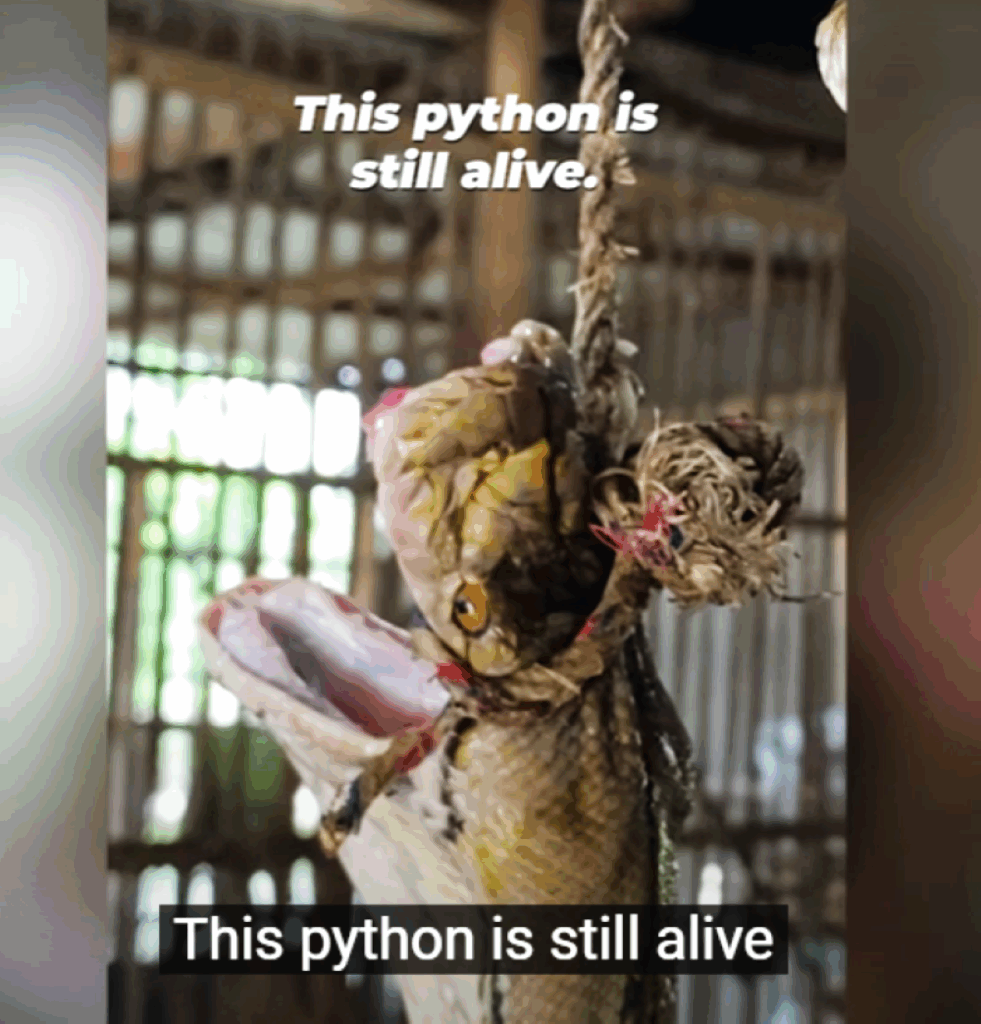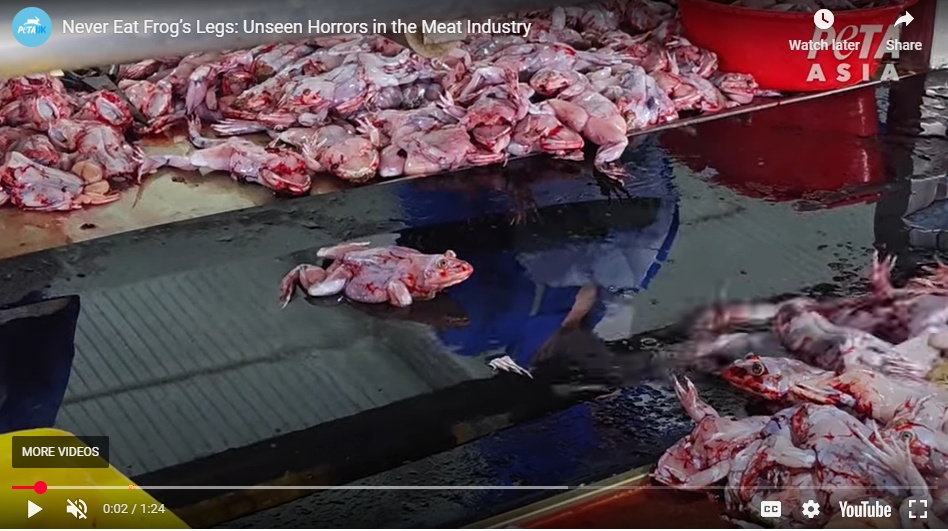
My dad was Jewish. He died in 1984 when I was 14 years old. After that, I was raised by a Black man named Dennis, who became my real father. The stories I heard growing up about slavery and the Holocaust are painfully reminiscent of what is happening to animals around the world every single day.
I first wrote and recorded “Where is the Geneva Convention for Animals?” in March 2014. At the time, I was deeply involved in animal welfare. With the rise of social media, I began seeing more and more footage of animals being tortured, abused, and killed for countless reasons.
Even when countries go to war, international law protects people from being tortured. The Geneva Convention, created in 1949, ensures that prisoners of war will not be tortured. Yet animals, who have done nothing wrong, get no such protection and are shown no mercy.
Even our enemies get treated better than innocent animals do. I started asking myself: Where is the Geneva Convention for Animals?
My name is Scott Smith. I am from South Florida, originally from New York. I run the DriveWithCompassion(dot)com and the online communities “Everybody Loves Sammy” and “Dr. Harp Seal.” – For over 15 years, I have been deeply involved in animal welfare, rescue, and activism.
In this piece, I will take you through many of the horrors being inflicted on animals across the world. We will face the cruelty that so many look away from either because they have become desensitized to it, or because it is too painful to watch. We have to remember that as difficult as it is to read, see or hear the atrocities being inflicted on animals, that is nothing compared to what the animals are actually experiencing. But I will also point out progress made with respect to animal welfare and share a few silver linings that give us hope.
A couple of thoughts readers should take with them through this article:
- The only thing it means when people say that humans are smarter than animals is just that, people are smarter than animals. It does not mean anything more than that. If it did, the strongest kid in high school would just walk into class and start beating everyone up. But that is not how it works, right?
————————————————————————————————————————————- - Just because certain laws allow many of the atrocities inflicted on animals does not mean they should be carried out. What about morality? What about compassion? What about humanity? – Remember, it was legal to own slaves for 246 years in the United States. How does that law look now? Overall, the laws still have it wrong when it comes to animal welfare.
————————————————————————————————————————————- - Corporations need to understand that just because there is a demand for something does not mean it has to be filled. It cannot always be about the money. Nobody is disputing the importance of money either. What is in dispute is the idea that money is important enough to justify tormenting, torturing and heinously killing animals every single day. No, it is not. We want to see corporations moving out of the animal cruelty business or better yet, never entering it in the first place whether there is demand for a product or not. And not because of public outcry or buzzwords like “sustainability.” No, that should not be the reason. It should be because many of these businesses were wrong from the very beginning. If corporations authentically move in the direction of morality and compassion, people will follow.
————————————————————————————————————————————- - We have to bring compassion into our lives. Even if people don’t care about animals, they should at least feel enough compassion not to hurt them. For example, I’m not a kids person. I never wanted kids. I don’t want to be around them. But does that mean I’m looking to hurt them? No. Of course not. Does that mean I wouldn’t pull a child out of the street if I saw them about to be hit by a car? Of course not. I would help them in a second. I would ask the same of people who don’t really care for animals.
————————————————————————————————————————————- - When you listen to the recording or read the transcription of “Where is the Geneva Convention for Animals?” you will notice I refer to myself as Dr. Harp Seal, an animal activist character I created in 2012. This character was inspired by the annual Canadian seal hunts and my dog Sammy, who resembled a harp seal. True story. At the very end of this article, Dr. Harp Seal will leave behind a doctrine for animals.
————————————————————————————————————————————-
It is a privilege to bring you this story today. I am not a fancy or politically correct person. I am a simple man who will say what needs to be said and in the way it needs to be heard.
This article will cover the following issues:
- The Where is the Geneva Convention for Animals
- The Fur Trade and other Animal Materials
- Canada – The Seal Hunt
- The Exotic Skin Trade
- Bullfighting and Galgos Dogs of Spain
- Animal Experimentation – National Institute of Health
- The NIH Non Animal Research and the CARGO Act
- The “So Called Expendables”
- Factory Farming
- The Dairy Trade
- Camels and Donkeys
- A Doctrine for Animals
- Dr. Harp Seal with the transcription of this message
- The DriveWithCompassion movement
Below is the original audio message of “Where is the Geneva Convention for Animals,” written and recorded in March 2014. If you prefer to read it, the full transcription follows below the audio.
The article continues below the transcription.
“Good evening, friends. Dr. Harp Seal here. Thanks for stopping in tonight.
Lately, I have seen many disturbing images regarding animals on our platforms. I want to try to deliver a message that encompasses all of it. I am going to speak from the heart here. I do not want to sound fancy or smart. Please stick with me for just a few minutes.
When I see all the abuses around the world, from the seal hunts in Canada we always speak of, to dolphin slaughters in Japan, the dolphin slaughters in the Faroe Islands of Denmark, dog fighting, bullfighting, the exotic hunts in South Africa, canned hunts, bear baiting, bear bile farming, the treatment of pigs throughout the EU, the horrific traps and hunts that take place with foxes, wolves, and coyotes, the laboratory experiments on monkeys for a whole multitude of reasons, all the animal victims of the fur trade, the dog and cat meat trade in many Asian countries, and the process of their actual demise. In China, South Korea, Vietnam, and Cambodia, they skin animals alive and then cook them alive. It was unbearable to even speak those words just now.
In Romania, the way they slaughter stray dogs and kill dogs in shelters. And let us not forget the killing of stray dogs in Russia for the Olympics that just took place. And so on, and so on, and so on. The main question that flashes before my eyes is, “Where is the Geneva Convention for Animals?” Our enemies get treated better than animals. Even in war, there is a code of honor. We have all heard the phrase “Honor amongst thieves.” How is it that animals, who committed no crime, who stole nothing, are sentenced to a life of slavery and torment, and a guaranteed death?
One comment I would like to make on China specifically: your economy might be leading the world, but your acts of evil towards animals supersede all the glory. As the rapper Ice T said in 1993, “You better check yourself.” China, it is time to lead by example, not by tyranny.
I want to make a prediction on the record, for the record: In the future, we will look back at the treatment of innocent animals, and it will look just as bad as slavery and the Holocaust do to us now. I am guaranteeing this. It is not a question of “if,” it is a question of “when.”
We are all witnessing, day in and day out, a quiet unspoken 21st century Holocaust for animals. So I will repeat: “Where is the Geneva Convention for Animals?” – Also, if you remember, Sammy and family revised the slogan “Guns don’t kill people, people kill people.” The revision is: “Guns and people kill animals and people.”
Thank you. Good night, everyone.”
———————————————————————————————————————————
None of Our Values Are Important Enough to Make Animals Suffer – The Fur Trade
This was a fox named D2, living on a fur farm in Wisconsin, the largest fur producing state in the United States. What D2 endured on this farm, along with his other fur mates, is incomprehensible. Look at the infection around his mouth. If you watch the video at about the 1 minute and 34 second mark, you can hear him struggling to breathe.
The fur farmer said he kept D2 for years and bragged about masturbating him so he could breed more foxes. He said he was only one of seven people in the world who could successfully masturbate foxes.
D2 was eventually killed by being shoved into a metal drum with other foxes and minks, then pumped full of dirty exhaust gas from a running engine, crudely and cruelly suffocating them.
I’m going to take a moment here, as the writer and producer of this article, to say something personal. I truly question the character of people who still wear fur knowing how it comes to market. I have felt this way for a long time, but the video above and this article have permanently solidified that belief for me.
Each year, approximately 100 million animals are killed for their fur. The main five animals killed on fur farms are mink, foxes, rabbits, chinchillas, and raccoon dogs. They are born into captivity, live in Auschwitz-like conditions, and are then heinously killed by electrocution, being gassed to death and having their necks snapped if they are small enough, or bludgeoned to death by having their skulls smashed with clubs.
The animals are kept in small, filthy, wire-floored cages for six to eight months until they are slaughtered. They literally go psychologically crazy because they are stuck in small cages, running in circles their entire lives. Many animals are caged above piles of their own waste a foot tall. I will repeat: Where is the Geneva Convention for Animals?
Hell in the bible is not proven. But hell in real life is Very Real for countless animals worldwide.
Are any of our vanities worth the atrocities being inflicted on these innocent animals? The answer is a straight up “No.” We all need to say “NO” to fur permanently. It is so sad that corporations look the other way on morality, but kneel to profits.
We need leaders right now, not conformists. Animal welfare is a state of emergency.

Above is a rabbit fur farm in China.. You can click on the picture to see the video. Absolute barbarism. The workers bash the rabbits over the head twice with a metal pipe. Then, while the animals are still fully alive, they hang them upside down and slash their necks with a long knife, making sure the cuts are as wide open as possible. As this is happening, the other rabbits watch in terror, knowing they are next. These practices are cruel and deeply disturbing.
Vegan FTA shows us how sweet and happy fur farm type animals could be if they were free.
It should be known that 50 percent of the world’s fur market comes from China.. Based on what I have learned about the plight of animals worldwide, China has one of the worst records on earth when it comes to animal welfare. The pain and anguish they inflict on animals on fur farms is incomprehensible. Complete and utter savagery. There are basically no laws protecting animals in these regions. Perhaps that is why they can deliver these products much cheaper than other countries.
Animal cruelty is a state of emergency. Say “NO” to fur forever. Also say “NO” to all the Animal Materials below. Let’s get into the “We World” and out of the “Me World.”
Each of these materials comes from the bodies of animals who are bred, confined, and exploited for human use. These animals are used until they can no longer produce what people want. Once their bodies are worn out, they are either killed on site or sent to slaughter for meat.
Leather – made from the skin of cows, pigs, goats, and other animals.
Wool – taken from the fleece of sheep.
Down – the soft layer of feathers from ducks or geese, usually plucked from the chest.
Mohair – from the Angora goat.
Angora – from the Angora rabbit.
Silk – produced by silkworms, usually boiled alive in the cocoon stage.
Cashmere – from the undercoat of Cashmere goats.
Shearling – made from the skin of recently shorn sheep or lambs, with the wool still attached.
Alpaca – taken from the fleece of alpacas, animals native to South America.
Not all animals are sent to slaughter. If the animal is too sick, injured, or thin to make a profit, it may be killed and discarded instead. Some are destroyed to avoid transportation costs. Others are killed on site because their meat has no market value or because their bodies are needed only for a specific part like feathers or fur. The decision depends entirely on money. If the animal can still bring in profit, it is used again. If not, it is disposed of.
—————————————————————————————————————————–
Canada – Friend or Foe? – Let’s Ask the Animals

Well, in terms of the Westernized world, everybody loves Canada.. The people of Canada are nice, polite, and progressive. Canada has stable institutions, solid infrastructure, and is governed democratically. There is a lot of decency and humanity when it comes to how they treat people.
However, when it comes to animal welfare, I find Canada to be a foe to animals than anything else.
Remember, Canada harbors one of the most barbaric hunts on Earth: the annual seal hunt, where thousands of baby harp seals and some hooded and grey seals are clubbed or shot to death. They argue it is for the benefit of Indigenous people, but that is a separate, small-scale, culturally important hunt. The commercial seal hunt, which causes the greatest suffering, is a large-scale activity driven by greed and carried out mostly by non-Indigenous sealers (hunters). It is really a pre-fishing season cash grab by some of the most heartless people on the planet. I do not even consider them human.
Even if sealing were still a booming industry, it was never OK.. It’s supposed to be ‘Lives before profits,’ not the other way around.
Canadian regulations require sealers to deliver three strikes to the seal’s head with a metal club to be considered a humane kill. Now, think about that for a moment. Think about clubbing an animal in the head three times. Now, think about getting clubbed in the head three times. Does that sound humane? It’s a disgrace for Canada to even propose that is humane.
The International Fund of Animal Welfare (IFAW) has been combatting the commercial seal hunt since 1969.. Between their efforts, other organizations as well and public outcry, the seal fur industry has crashed.
Seal fur has been banned in dozens of countries, including the European Union since 2009, along with the United States, Russia, and Mexico. These bans have drastically reduced demand for seal products. In 2006, Brigitte Bardot, through her Brigitte Bardot Foundation tried to buy the sealing licenses and so they would give up the hunt and seek different ways of making a living. Her exact quote was: “I am willing to personally finance a project to help sealers transition to other industries… This slaughter must stop.”
While over 300,000 seals were killed annually from the 1980s through the early 2000s, that number has dropped by roughly 90 percent to about 25,000 seals a year today. According to IFAW, the commercial seal hunt still exists because of political reasons. Sadly, that offers little solace to the 25,000 seals still bludgeoned to death each year.
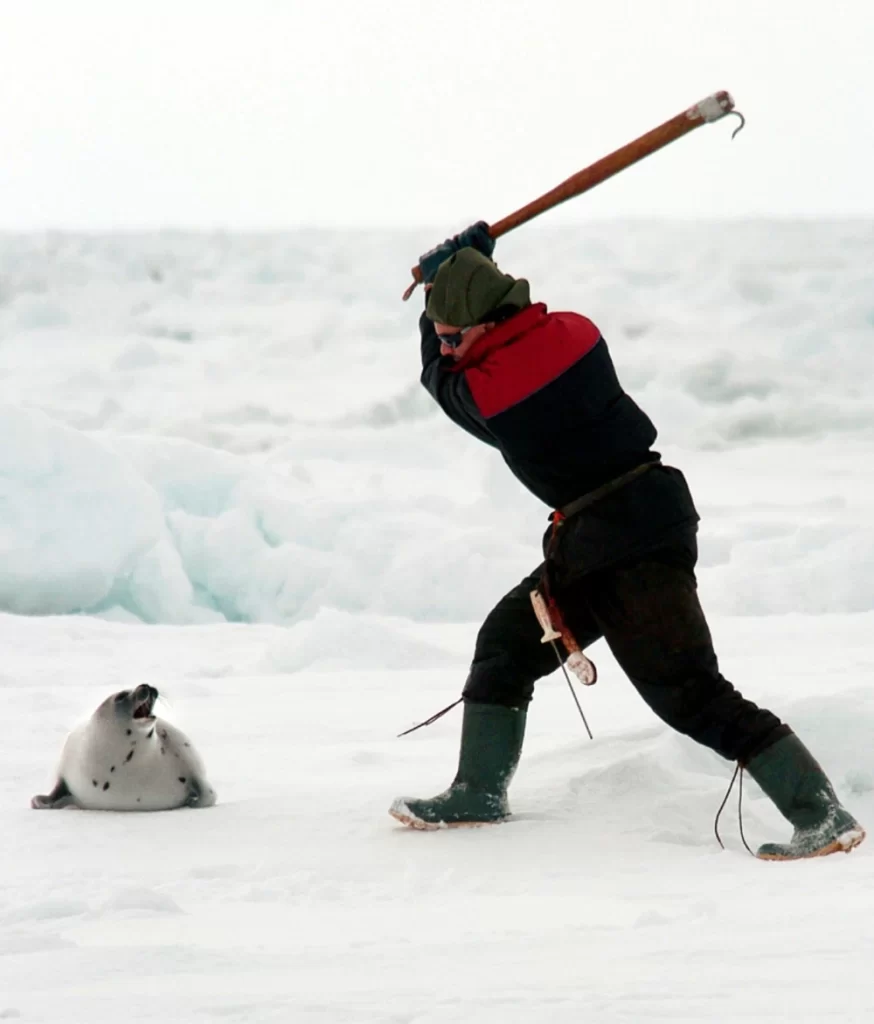
My first exposure to the seal hunt – Who is Dr. Harp Seal?
I first learned about the Canadian seal hunt on television when I was 10 years old, in 1978. – It was the most traumatizing thing I had ever seen. I could not believe what I was witnessing: men clubbing baby harp seals over the head. while fellow seals looked on in horror, knowing they were next. The only other time I had ever felt such horror was watching the movie Jaws in 1975. Millions of people around the world refused to go into the ocean for years because of that film. But that was just a movie. The seal hunt is a real life horror for seals, and it actually takes place in Canada every year.
In 2012, I created the Dr. Harp Seal character to raise greater awareness of one of the world’s most barbaric hunts, the annual Canadian seal hunt. My dog Sammy looked like a harp seal. He also always made people smile and feel better. He reminded me of a doctor because doctors make people feel better. And the truth is, If think back to the 10 year old boy he first saw the barbaric seal hunt in Canada on television, I’m not surprised that 34 years later in 2012, I created an incredible animal activist character, who happened to my late dog’s Sammy’s alter ego, Dr. Harp Seal.
————————————————————————————————————————————-
The Exotic Skin Trade – Hell on Earth all in the name of Profits
Louis Vuitton, Hermès, and Gucci have made it very clear they are in the business of torturing animals to death for profits. They have no problem ratcheting up the cruelty either to squeeze profits even further. Other luxury brands also participate in this barbaric trade. Their mantra is “Profits before Lives” when it’s supposed to be the other way around. These corporations have blood on their hands. Please think twice before ever buying products from these companies.
It’s not radical what I’m saying. It’s radical what these corporations are doing to animals.
The main countries involved in this barbaric trade include Vietnam, Indonesia, China, Thailand, the Philippines, and several African nations. Vietnam is especially notorious for the brutal treatment and mass slaughter of snakes and crocodiles.
Snakes are often tied, nailed, and hung alive or semi-conscious to preserve the quality of their skins. Their mouths are forced open and tied with rope to prevent biting, then nailed through the head or jaw to immobilize them as their bodies hang downward. This stretches the skin for easy removal in one long piece. Every part of this process is designed to protect the skin’s appearance and market value, with the animals’ pain and suffering completely ignored.
If you click on the picture above or below, the video will play.
In addition to hanging, snakes are often inflated with air or water pumped through the mouth or anus to stretch their skin even further. Inflating the snake forces air into the body cavity, expanding it unnaturally. This pressure disrupts lung function and prevents the snake from breathing properly, causing suffocation. When water is used, it floods the body cavity and lungs, cutting off oxygen entirely and leading to drowning. Water inflation also causes severe internal damage and organ failure, prolonging the animal’s suffering until death.
These cruel inflation methods serve no purpose other than to stretch and preserve the skin for sale, with no consideration given to minimizing suffering.

Crocodiles endure similar or even worse torment. After often ineffective stunning attempts, workers cut into the back of the neck or skull and insert a metal rod into the spinal column and brain—a method called pithing. The rod is moved around to sever the spinal cord and destroy parts of the brain, which paralyzes but does not kill the animal. The crocodile can remain alive and fully aware while it is bled and skinned, all to preserve the flawless appearance of its hide. Hermès is also a key perpetrator in the farming of wild crocodiles.
If you click on the picture above, the video will play.
I want to repeat that again: workers cut the back of the crocodile’s neck or skull and then insert a metal rod into the spinal column and brain. The rod is moved around to sever the spinal cord destroying parts of the brain and paralyzing the animal. It does not kill him. The crocodile takes in this whole experience fully conscious.
Remember the snake and crocodile in this article and never forgot what Louis Vuitton, Hermès, and Gucci are really about. They torture animals to death for money. That’s what they do.
The raw skins are then sent to tanneries where they undergo tanning, a chemical process that preserves and strengthens the leather to make it durable and flexible for luxury products. Designer brands typically purchase these tanned exotic leathers and craft them into high end finished goods. Most of this production happens outside the countries where the animals are sourced.
After luxury brands purchase the tanned exotic skins from suppliers, the leather is shipped to their workshops or contracted manufacturers often located in Europe or other luxury hubs. There skilled artisans carefully cut, shape, and sew the leather into finished products like handbags, belts, and shoes. Every step focuses on craftsmanship and maintaining the skin’s flawless appearance to meet the high standards and prices of luxury fashion.
Some of the main products made from these exotic skins include handbags, wallets, belts, shoes, watch straps, jackets, gloves, phone cases, luggage, and other small leather goods.
This cruelty is about maximizing profits by preserving perfect skins at the expense of sentient beings who suffer in silence. The pain and suffering of these animals are hidden from consumers behind labels and luxury branding.
But they do not have to suffer in silence anymore. I urge everyone reading this article to think twice before purchasing any products from Louis Vuitton, Hermès, Fendi or Gucci. No matter how much these companies promote buzzwords like sustainability, ethical standards, and environmentally friendly practices, the reality is that they are committing atrocities on these animals. It’s time for us to open our eyes and refuse to support cruelty in the name of fashion.
————————————————————————————————————————————-
The Shame of Spain: Bullfighting and Galgos Dogs
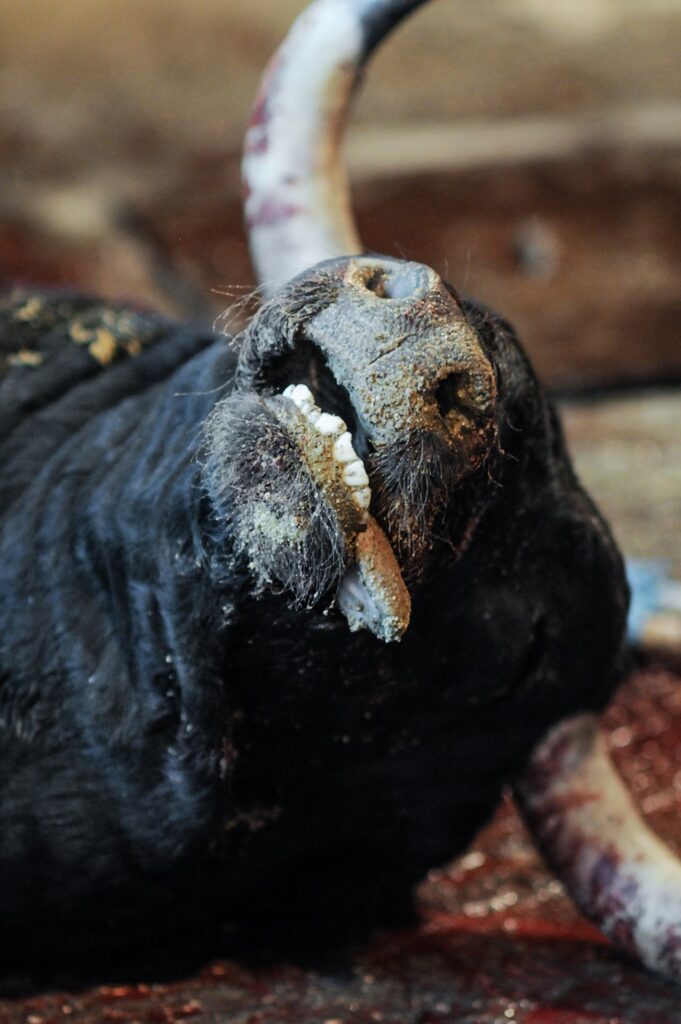
Did you know that after being repeatedly stabbed and choking on your own blood, just moments from death, if someone then cuts your ears off, you will still feel unimaginable pain? Did you know that? Well, that is the moment when the people in the crowd stand and applaud the matador who cut the bull’s ears off. Think about that for a moment.
For a country so rich in culture and history, Spain has one of the worst animal welfare records on earth. The violence and cruelty reach another level. Spain is the epicenter of bullfighting. Yes, other countries share the guilt, but Spain has upheld this practice for hundred of years in the name of tradition. That no longer flies in today’s world. This is not tradition. It is murder done in the cruelest ways. And people actually pay money to watch such barbarism.
Inside the Bullfighting Ring: From Spears to Death
It begins with two mounted bullfighters who jab the bull’s neck with long spears. This forces the bull to lower its head and grow weary, making it easier for the matador to take control. The matador stays close by, using a cape to guide and provoke the bull, sizing up its strength and behavior before his turn.
There can be no true humanity without animal welfare. They go hand in hand.
Next, three men on foot each drive two barbed sticks into the bull’s shoulders for a total of six. By now the animal has suffered deep wounds and severe bleeding. Its body is bruised and its muscles torn. The repeated stabs inflict excruciating pain, leaving the bull weakened but still forced to fight. These barbed sticks are meant to wear the bull down and make it angrier and less able to charge with force. At this point, the bull’s head rises again, setting the stage for the final act.
This is where the Matador steps in. The bull has endured about a dozen blows. It is weak and bleeding to death. Its wounds have caused massive blood loss, draining its energy. The matador uses the red cape to provoke one last charge. After a few tired attempts, he drives his sword between the bull’s shoulder blades and the bull falters and falls.
All too often the bull does not die right away. To impress the crowd, the matador then stabs the bull at the base of its skull with a short knife and cuts off its ears while the animal is still alive. As the bull chokes on its own blood, it still feels the unimaginable agony of its ears being severed. You can see it thrash its back legs in a desperate attempt to escape the pain.
Now, it’s true that the people of Spain are waking up to the reality that bullfighting is more about barbarism than tradition and culture. Many subsidies have been cut by both the European Union and the Spanish government, which is a positive step. However, the bullfighting industry still benefits from loopholes in farm subsidies. As such, thousands of bulls are still being tormented and tortured to death each year.
Galgos Dogs of SPAIN — Do you like to Piano?

Because Spanish hunters enjoy making Galgos dogs do the “Piano Dance.”
In rural Spain, Galgos dogs, also called Spanish Greyhounds, are bred in massive numbers for hunting hares. To the hunters who use them, they are tools, not companions. The SPCA International reports that roughly 60,000 Galgos dogs are killed in Spain every year. These gentle, sensitive dogs suffer horrific abuse, including burning and beating them, throwing them into wells, burying them alive, dragging them behind vehicles, and poisoning them. Many of these acts stem from a twisted superstition that the slower and more painful the death, the more luck it will bring in the next hunting season. This belief gives the violence a false meaning, but it also masks a deeper cruelty. Beyond superstition, many hunters show a sadistic disregard for life, using these dogs purely as tools and inflicting extreme suffering simply because they can.
Did you know Spanish hunters like to play the piano with Galgo Dogs? But, not in the way you think.
One of the most disturbing practices is the so called piano method, where Galgos dogs are hanged from trees with their back legs barely touching the ground. They fight for hours, struggling to stay alive, until exhaustion takes over and they are slowly strangled to death. This is often done at the end of the hunting season, once the dogs are no longer seen as useful. Dogs that do not perform well are starved, beaten, or killed to cleanse shame before the next season. Some are also starved before the season begins, under the cruel belief that hunger makes them hunt harder. This is not isolated cruelty, but a widespread, culturally accepted tradition.
The hares themselves also suffer terribly. These wild animals are chased relentlessly for sport, pushed to exhaustion, injured, and often killed by the dogs. The practice causes severe suffering to both the Galgos dogs and the hares, making the tradition cruel to all involved.
————————————————————————————————–
Hunting is a Sick Perversion – It’s Not a Sport
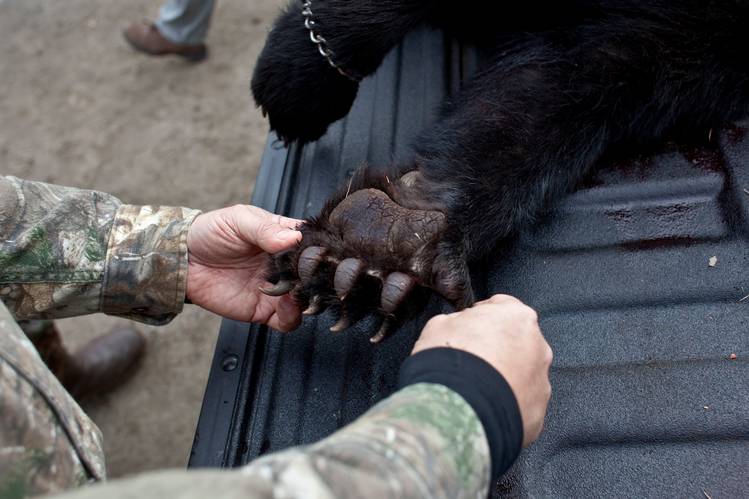
I’m not talking about hunting for food. But, that’s not what 400 million guns in the United State is about. And that’s not what killing contests all over the United States and around the world are about. A sport requires two consenting teams that want to play. I am certain animals do not want to play this sport. Therefore, it’s taking a life we don’t have the right to take. The laws have it wrong on hunting,
Now, let’s get into the annual New Jersey black bear hunt:
There are two parts. Segment A takes place the week after Thanksgiving. For six days, hunters are allowed to use bows and arrows for the first three days, and both bows and rifles for the last three. Segment B begins on the second Monday in December and runs another six days, allowing rifles and muzzleloaders throughout. A muzzleloader is an older style firearm that must be loaded from the front of the barrel.
I never got the Email from God or Mother Nature saying people can decide which animals live, which die, and by what numbers.
In 2024, last year, 5,766 hunters applied for permits according to the New Jersey Division of Fish and Wildlife. Out of those, roughly 4,200 permits were issued. Yet only around 500 bears were killed. That is nearly ten times as many hunters as bears killed. Think about what that reveals. If this hunt were truly about population control or public safety, would it need that many people chasing that few bears? Or is it something else? Is it about the chase? The anticipation? The thrill of the kill? Because the numbers do not lie. It’s not efficiency. It is indulgence. Some do not just use rifles. They prefer bows and arrows so the death drags out, letting them bask in the bear’s demise. The bear hunt makes all of this very clear.
In my article “The Second Amendment from the Perspective of an Animal,” which was originally written and recorded in March of 2014, I talked about how animals were not mentioned once in the Second Amendment but sure do take the brunt of it. I also pointed out how people are always finding reasons to to kill animals: trophy hunts, canned hunting, deer farms, and the New Jersey black bear hunts. Some claim it is to feed locals. Others say it is to raise money for children’s hospitals or community services. And that’s nice. Here’s the thing, you can still make the donations to the kids with cancer. Just cut out the shooting the animas part and it’s all good.
————————————————————————————————————————————-
Animal Experimentation Hell — What Is It Good For? — It’s Good for MONEY
DriveWithCompassion(dot)com is firmly against animal experimentation. We do not care if humans benefit from the research, which most of the time they don’t. But, let’s say it actually did benefit people, we still don’t care. It is unacceptable in any universe to torment and torture animals until they die or are killed. Even if the animals stuck in laboratory hell were not experimented on, just think about them spending their whole lives in small cages and never seeing sunlight. They must feel deathly alone and become psychologically disturbed, just like we would.
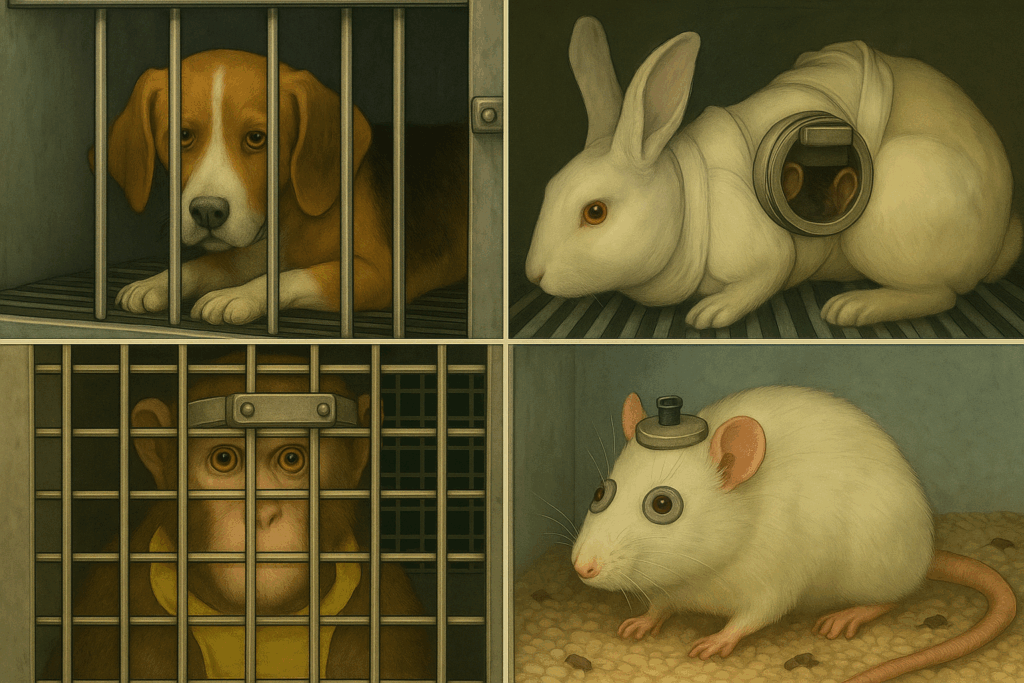
According to PETA, up to 90 percent of experiments on animals fail to produce results that apply to humans. Most animals used in research are trapped in a profit driven cycle where their suffering fuels financial interests rather than meaningful medical advances. This substantiates that much of this research is driven by money and the flow of grants, not genuine scientific progress. The world’s values are inverted. It is supposed to be “Lives before Profits,” not the other way around. Until we understand that, Mother Nature will continue to blast us with unprecedented hurricanes, earthquakes, and floods. It is directly related to humans torturing and killing animals all over the world.
Governments, universities, and corporations spend anywhere from 50 billions to over 100 billion dollars per year on animal testing. This includes the National Institutes of Health (NIH), which is the largest funder of animal testing in the world. A huge portion of this money goes toward pointless, redundant, and cruel experiments that serve no legitimate benefit to human health.
Do we really need such experiments? Anyone with common sense already knows better.
In laboratories around the world, animals face procedures they cannot consent to and would never choose. They are burned, poisoned, paralyzed, mutilated, and deprived of food and water. Invasive surgeries, toxic drug testing, forced infection, and physical restraint are routine. Countless animals endure psychological torment from isolation, captivity, and repeated handling with no relief. Pain relief is often withheld. Nearly all are killed when the experiment ends, not as a tragic outcome, but by design.
Let me be clear, I am not against science. I am against using animals as test subjects in the name of science. Animal experimentation is more about the money than the research itself.
I’m going to list some of these sick, cruel experiments below, each with a blue source link. Then I will respond with common sense answers in red, without any scientific background.
– Forcing mice to swim in tall glasses until they give up to test for depression. – I would become very depressed if I was running out of energy knowing I’m about to drown. Research? Really?
– Making beagles breathe in cigarette smoke through gas masks. – I’m sure I would become addicted to nicotine and develop lung and respiratory issues. Research? Really?
– Did the Oregon Health & Science University really need to have small rodents drink the equivalent of 15 bottles of wine a day to see if it would impact their social behaviors. – Let me guess, drinking 15 bottles of wine a day DID IMPACT their social behaviors. Research? Really?
– Beagles being force-fed Oxycontin... Look at what they did to this dog. – I would be high as a kite and sick to my stomach if I was force-fed Oxycontin.. Research? Really?
– Force feeding mice parasite infested feces, then killing and dissecting them. They do this to beagles as well. – I’m guessing this can cause fever, vomiting, and organ failure from being poisoned.
– Feeding animals high fat diets and human feces to track obesity or digestion. – Let me guess, the animals become obese and are prone to strokes and heart attacks.
– Repeatedly shocking monkeys to study stress reactions. – I’m pretty sure if I were repeatedly electrocuted, my stress levels would be very high. Research? Really?
– Placing mechanical snakes and plastic spiders in cages with baby monkeys to provoke intense fear. – Let me guess, the baby monkeys were terrified. Research? Really?
– Force feeding rats chips, candy, and glucose, then taking their blood repeatedly. – Let me guess, this would make people more susceptible to diabetes.
– Dropping chemicals into the eyes of rabbits with no pain relief. – I’m sure this causes the eyes to feel irritated and painful, and it reduces visibility
– Making beagles ingest pesticides at Charles River Laboratories in Michigan. – I’m pretty sure being ingested with poison will make me very sick or die.
– Testing new household cleaning products by burning skin or causing internal organ failure. Let me guess, this is extremely painful and damages organs.
– Feeding animals glass beads mixed with human feces and a high fat diet. – Eating glass mixed with feces causes immense suffering and destroys the animal’s health. Research? Really?

These rats above on the right side of the collage picture are placed in restrained tubes that are connected to machines releasing the gas form of the test compound. Depending on the experiment, they may remain there for minutes, hours, or be subjected to the procedure daily for weeks or even months.
Whether taken from the wild or born in captivity, their lives are filled with suffering. Some of these animals are not bred in facilities but are taken directly from their natural environments. Primates are often trapped violently, their family groups torn apart, and shipped in crates across continents. Marine animals like dolphins and octopuses, along with birds, reptiles, amphibians, and fish, are also captured from the wild for research. For them, the trauma begins not in the lab but the moment they are torn from the wild. Captivity alone becomes a form of suffering.
To make matters worse, mice and rats, who make up the vast majority of animals used in research, are not even protected by the Animal Welfare Act. Many times, the animals who are supposed to be protected are not. The law is full of loopholes, and enforcement is weak. Behind closed doors, suffering is invisible and accountability is rare.

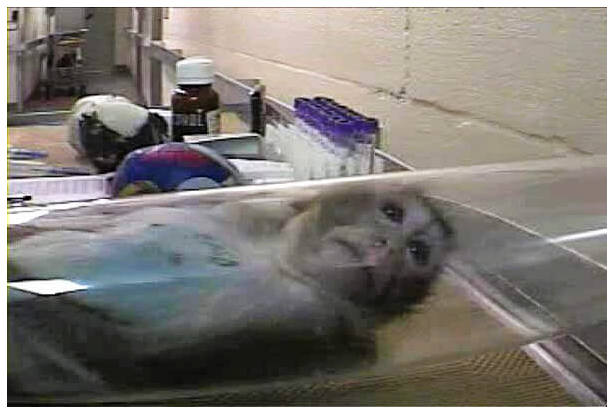
The image on the left is a beagle being debarked by having its vocal cords cut out without any pain relief. I know what you are thinking. What kind of research would that be for? Great question. It’s not about research at all. It’s about the researchers being annoyed by the barking of dogs locked in their labs, animals who spend their entire lives in small cages, scared to death, tormented and tortured with all kinds of experiments.
Did you ever wonder how animals in research laboratories see humans? – This two minute and forty two second clip from the 1993 movie “Fire in the Sky” answers that question, I believe. – It is a life changing scene.
Think about that for a moment. This research lab from hell, known as both High Quality Research and Red Beast Laboratories in Fort Collins, Colorado, should be shut down permanently. Full stop. It should be known that Colorado State University has ties to Red Beast Laboratories. There are many universities and corporations inflicting horrors on animals through companies like Red Beast Laboratories all over the United States. Take the University of Wisconsin Madison, for example. They are considered the worst animal welfare violators among the top 20 research universities, according to a PETA study.
On the upper right, at Covance, a mega contract testing laboratory located in Virginia, monkeys were placed in cylinders to restrain them during testing and experimentation. Here are 10 animal torturing devices commonly used in research labs all over the world. The things that were done to these monkeys and the horrors they endured remind me of what I learned about the death camps at Auschwitz. Covance is now owned by Fortrea Holding, one of the largest participants in the international primate trade. Fortrea Holding and Red Beast Laboratories are the concentration camps of the twenty first century.
Thanks to PETA, this particular death camp in Virginia was closed down. A major victory for animals. It is a very hard video to watch, but this one ends well. Touchdown for animals.
The top 5 companies involved in animal research and testing
Charles River Laboratories in Massachusetts is the world’s largest supplier of lab animals like mice, rats, monkeys, and dogs, working with drug companies and government agencies but facing many investigations for poor treatment, especially of monkeys. Fortrea Holdings, formerly Covance in North Carolina, tests monkeys, beagles, rabbits, and rodents for drug and chemical companies and has been reported for harsh conditions and mistreatment. Inotiv in Indiana breeds animals like beagles, mice, and rabbits for research; after nearly 4,000 beagles were rescued from terrible conditions, the company pleaded guilty to animal cruelty and paid fines. Eli Lilly in Indiana uses rodents, dogs, and monkeys to test drugs early on but is criticized for painful experiments and secrecy while working with U.S. research agencies. Pfizer in New York uses mostly mice and rats, but also monkeys, rabbits, and dogs for drug and vaccine testing, claiming ethical practices but facing criticism for lack of transparency, especially about primates, while cooperating with federal agencies like the FDA.
Let me be very clear in case there’s confusion, there is nothing ethical about animals living alone is small cages waiting to have horrible things done to them. What a huge sham at the expense and anguish of animals. Sinful!
————————————————————————————————————————————-
The National Institute of Health – Monumental News for Animals
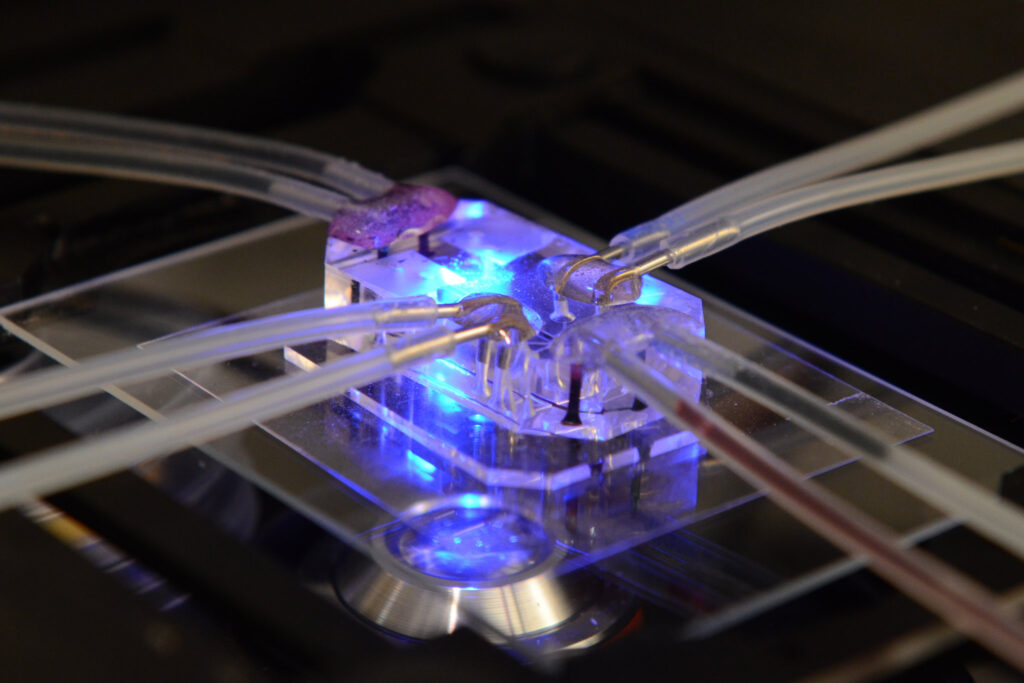
What You Are Seeing in the Above Image:
This is an Organ on a Chip. It is a small clear device about the size of a USB stick that uses real human cells to mimic how an organ functions. This is a form of in vitro testing, meaning it takes place outside the body in a controlled lab setting.
What Is Happening:
Thin tubes inside the chip carry fluids like nutrients, oxygen, or drugs, similar to how blood flows in the body. The chip contains tiny channels lined with living human cells from organs such as the lung or liver. These cells respond in real time. The blue light comes from a microscope that allows researchers to observe how the cells react to substances. No animals are used in any part of this process.
Before I get into how monumental this news is for animal welfare and experimentation, I want to remind people that the National Institutes of Health is the epicenter of animal experimentation. They have been in the worldwide torture and killing of animals killing business for a long time.
The amount of pain, fear, and cruelty they have inflicted on animals over the last five decades should never be forgotten. Every year, billions of taxpayer dollars fund experiments that poison, shock, starve, and mutilate animals in laboratories across the United States and in countries around the world.
In April 2025, the National Institutes of Health launched a new office focused on replacing animal research with these advanced tools. It is now tracking how much funding goes to non animal research and working to ensure fair grant evaluations for projects that use modern methods. This shift follows key recommendations from the Research Modernization Now roadmap, which calls for stronger support and training in human relevant science.
At the same time, the Food and Drug Administration announced it is phasing out mandatory animal testing requirements for certain new drug applications. For treatments like monoclonal antibodies, drug makers can now use human based methods instead. This shift is meant to make drug development faster, more affordable, and less harmful to animals.
But let us be honest. This will not help the animals suffering in labs right now. For them, nothing changes. They remain locked in small cages, waiting for the next round of experiments. So yes, this news is monumental. But for millions of animals, it comes too late.
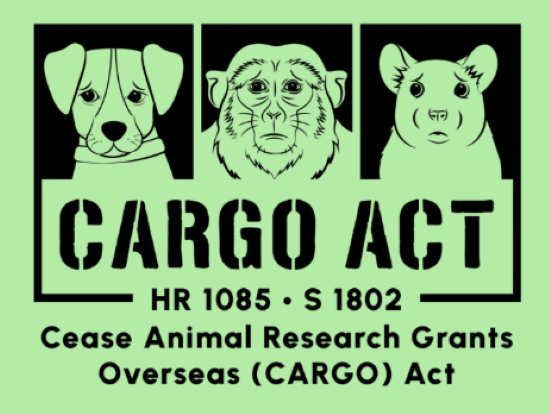
Yes, the NIH’s April 2025 announcement about moving toward non animal testing is a very important signal, and groups like PETA helped push for this change. Their pressure, along with growing public concern, suggests the agency is more open than ever to reforms like the CARGO Act.
While the NIH has not officially endorsed the CARGO Act, this shift signals a growing institutional awareness that animal experimentation is no longer the gold standard and that ethical concerns about animal use are valid and increasingly unavoidable.
The CARGO Act addresses one of the most egregious betrayals in the system, which is the use of retired government dogs in painful research. If the NIH is serious about moving away from animal testing, supporting this bill would be consistent with its new direction.
Legislatively, the CARGO Act is currently before both the House and Senate, with bipartisan support helping to move the bill forward. A legislative outcome may not be expected until late 2025 or early 2026.
So, while we cannot say with certainty that the NIH is backing the CARGO Act just yet, the tone has changed. The April announcement shows a softening stance, and public pressure from groups like PETA and bipartisan lawmakers is helping to push that shift even further.
————————————————————————————————————————————-
The “So called Expendables”
Billions of animals including frogs, crabs, shrimp, and lobsters are caught, farmed, and killed each year to satisfy global demand for their meat. These animals are almost never stunned or given any form of humane killing before enduring painful deaths. They feel immense pain and have a strong will to live.
Frogs have been seen kicking and struggling just before they are butchered for their legs. Approximately 1 to 2 billion frogs are killed each year. Most are taken from the wild and skinned while still alive. Only the back legs are used. The rest of the body is discarded, often while the frog remains conscious. You can all of this horror in this video.
Suffice it to say, nobody should be eating frog’s legs. If you didn’t know, now you do know. Let’s leave frog legs off our plates. Shame on the companies supplying this demand. There has to be a line where money is just isn’t worth committing such atrocities.
Crabs, too, suffer deeply. Around 1 billion crabs are killed globally each year. They are trapped and confined for long periods, then boiled alive without any attempt to reduce their pain. Crabs have been witnessed clinging desperately to the edge of pots to avoid falling into the boiling water beneath them. You can see Vegan FTA’s video showing just that.
None of our taste buds worth inflicting such horrors on innocent creatures.
Shrimp fight to survive as well. An estimated 10 to 12 billion shrimp are killed each year. When caught in massive nets dragged along the ocean floor, they thrash and swim frantically in attempts to escape. On crowded farms, they panic in polluted ponds, reacting violently to disturbances and handling. After capture, shrimp often suffocate slowly out of water or are boiled alive, enduring prolonged distress and pain. They suffer through the entire process, from beginning to end.
To force them to reproduce many female shrimp endure a practice called eyestalk ablation, where one of their eyes is literally cut off or crushed to manipulate their hormones and trigger egg production. The procedure causes extreme stress and likely pain, yet it remains widespread in the shrimp farming industry.
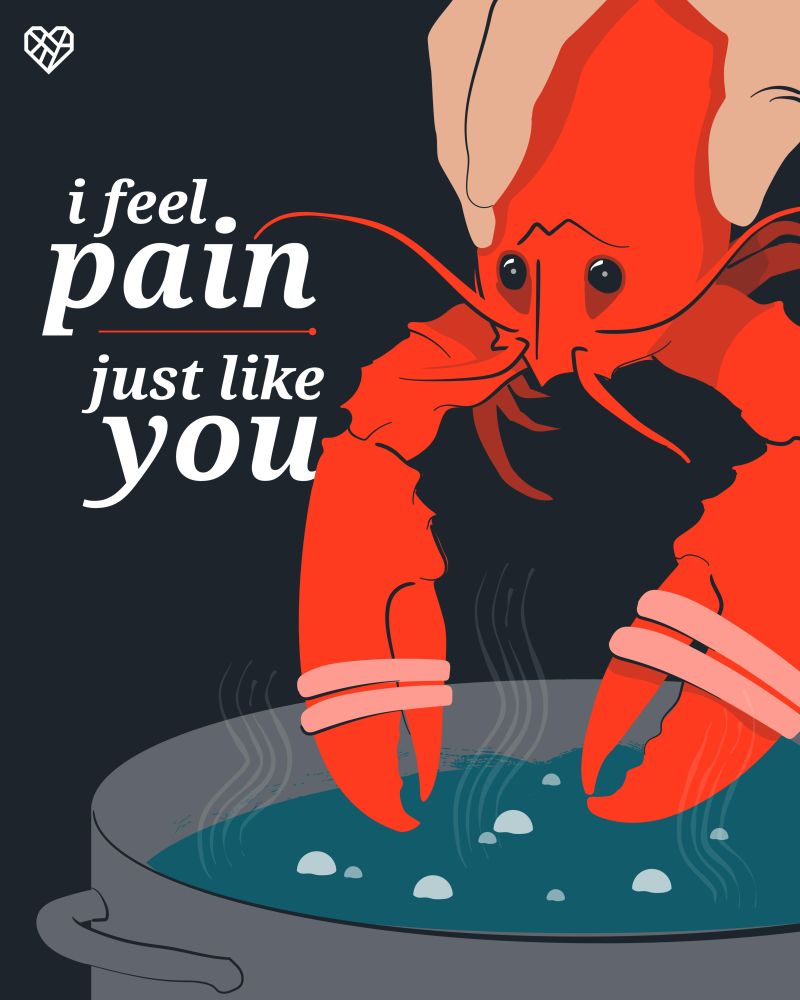
Lobsters are almost always killed by being boiled alive. About 200 million are caught each year. They are kept alive with their claws bound, often stacked in tanks for days. As they are lowered into scalding water, they are known to scream, a sound many interpret as a final cry of pain. When I was about nine or ten years old, my father was friends with the owner of a local seafood restaurant. Because of their relationship, he invited us into the kitchen one night in the late 1970s. I can still hear those lobsters scream. All these years later, at fifty six years old, that haunting sound remains with me. It is a vivid reminder that these creatures suffer deeply, even if most of the world chooses to ignore it.
Despite their differences in species, habitat, and biology, these animals share one fate. They are treated as products, discarded as waste, and subjected to extreme suffering from capture to death. They are called expendable, but they all fight to live.
——————————————————————————————————————————–
Factory Farming – The Biggest Tragedy in the History of the World
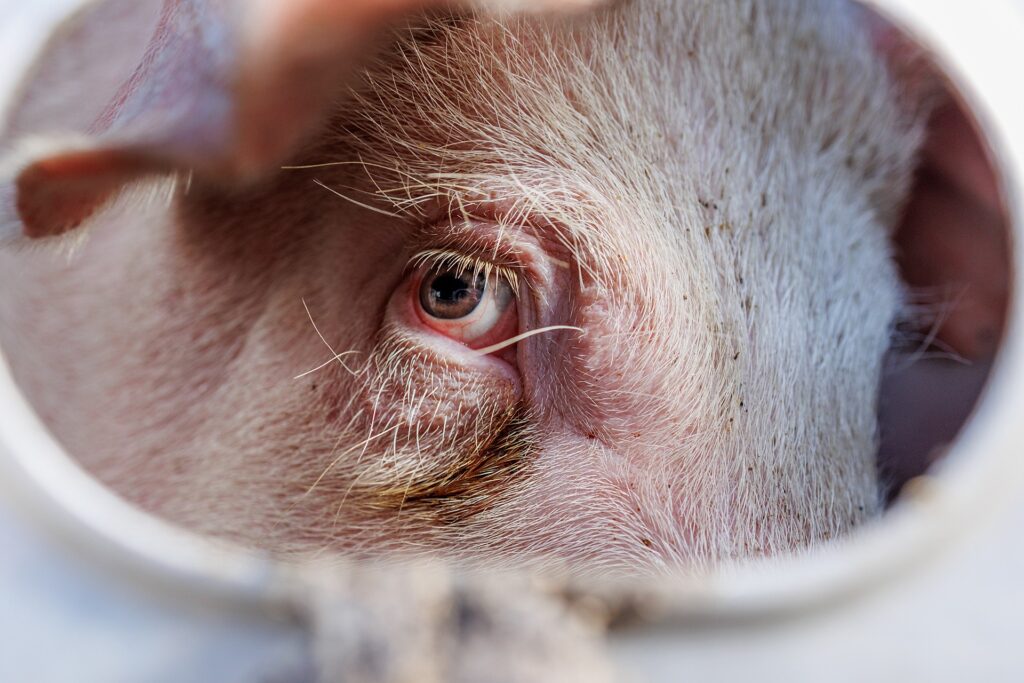
This pig in the transport truck above is only 6 months old. He lived in Factory farm hell the whole time. Now, he is on the way to the slaughterhouse where he will be gassed to death or electrocuted to death. He never experience kindness, love, or freedom. The only time he saw natural light when he was looking outside of the death truck at the photographer taking a picture of him. Since the picture was taken in 2021, over five billion more pigs have been slaughtered. Factory farming is systematic mass suffering and killing.
I’m not comparing people and animals. And I am also not not comparing them. But I will say this: factory farming is slavery and the Holocaust all over again. The death camps have been franchised throughout slaughterhouses all over the world. It is every bit as evil.
Now back to the pig in the truck from above, if gassing or electrocuting are not done properly, which many a time, it’s not, he will be conscious when his throat is slit and thrown into a scalding tank still alive. Undercover investigations have shown pigs screaming and thrashing in the tanks. Click ‘see reel” at the bottom of the link placed in the prior sentence. If that’s not hell on earth, I don’t know what is. All of this horror in the name of profits.
Would you believe me if I told you that the animal agriculture industry considers gassing pigs to death humane?
True story. Except it’s not humane. Pigs panic. Their eyes start burning. Their lungs feel like they are on fire. Pigs scream, thrash, and gasp for air for up to a minute before losing consciousness.
The video above comes from Farm Transparency Project out of Australia. This is the organization that brought the critically acclaimed movie “Dominion” to all of us. It is considered one of the most powerful exposes of factory farming ever made. They used hidden camera footage and drone shots to expose abuse in Australian animal industries, but the practices are common globally. Let’s always remember, as difficult as these cruelties are to watch or read about, it pales in comparison to what factory farm animals have to endure.
So what is the real reason gassing pigs to death has become the standard method of slaughter? It is about money. CO₂ gas is cheap, fast, and efficient. It allows multiple pigs to be killed at once in chambers. The animal agriculture industry also considers stunning animals with electricity to be humane. If that is what they call humane, one can only imagine what inhumane would look like.
Animals want to live: video by Kinder World showing how hard they fight to survive.
Would inhumane mean hanging animals upside down while they are still conscious? Because that already happens. Would it mean boiling pigs or chickens alive when stunning fails? Because that already happens. Would it mean grinding up baby male chicks alive simply because they cannot lay eggs? Because that already happens. Would it mean tearing calves from their mothers at birth and killing the males for being worthless? That happens too. Some male calves are immediately killed, while others are sent to veal factory farms before being slaughtered. Even their humane methods are painfully cruel. The animal agriculture industry tries to cover this up with feel good labels and carefully chosen words. But cruelty dressed in better language is still cruelty. And make no mistake, it is all driven by profit.
Mother Nature is blasting us with unprecedented hurricanes, floods and earthquakes. Is anyone listening?
It is also considered humane to slam the heads of sick or unwanted piglets onto concrete floors to kill them. This is called thumping. The American Veterinary Medical Association actually considers it an acceptable form of euthanasia. Thumping is also done to other animals, including baby goats, lambs, and even poultry. It’s barbaric is what it is.
Factory farm animals are born into slavery, live in Auschwitz like conditions, and are then heinously killed. Approximately 90 billion animals worldwide are raised on factory farms and then transported to slaughterhouses to be killed. The heartbreaking reality is that when they are killed, that is their ticket out of hell. A heinous death is actually better than the life they were forced to endure.
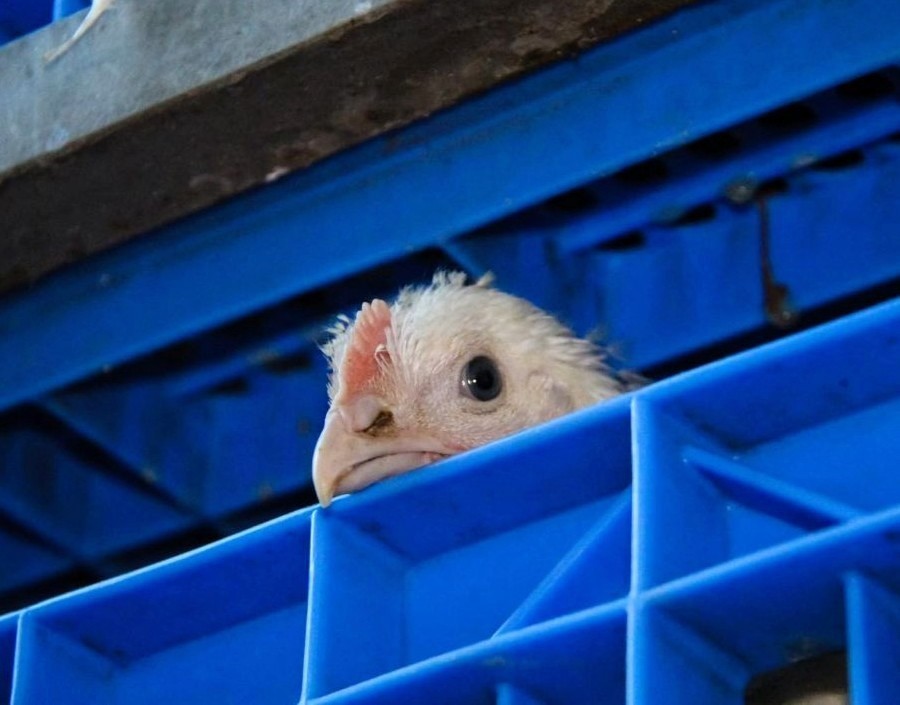
Let’s talk about chickens:
The above chicken lived a life of misery and is now on a truck headed to a slaughterhouse. This is the first and last time this chicken has seen the outside world and natural light.
Chickens are factory farmed far more than any other land animal by far. They are farmed about ten times more than any other species. Why? Because it costs less to raise them in terms of space and speed. Chickens raised for meat grow unnaturally fast, reaching slaughter weight in just five to seven weeks. Compare that to pigs, who take about five to six months, or cattle, who can take over a year. Chickens also require far less space. Factory farms cram tens of thousands of them into a single barn, cutting costs dramatically.
Six things you don’t know about Chickens. See this infographic.
They also convert feed into body weight more efficiently than pigs or cows, which makes them cheaper to raise. Add in the fact that chicken is often viewed as a healthier and more affordable option by consumers, and the demand continues to grow. Slaughtering chickens is easier to scale and less regulated. In many places, they are excluded from even the most basic animal welfare laws, leading to some of the worst confinement and suffering. Chickens are the most abused and overlooked animals in the world. On factory farms, they are treated like products, not living beings.
The main land animals raised on factory farms, along with the numbers slaughtered globally each year by Our World in Data:
Chickens for meat (about 70 billion)
Bred for fast growth and called broilers. These birds suffer leg deformities and organ failure, packed by the tens of thousands into filthy barns with no chance to act naturally.
Hens for eggs (included in the chicken total)
Bred solely to lay eggs. Confined in cages or crowded warehouses, denied sunlight, often with their beaks cut. Killed after about 18 months when no longer productive.
Pigs (about 1.5 billion)
Used for bacon and pork. Factory farmed pigs live in crowded sheds. Mothers are trapped in crates. Piglets face mutilation without pain relief, and weak ones are killed by head slamming.
Cows (about 300 million)
Dairy cows are milked constantly and separated from their calves. Beef cattle are confined to feedlots before slaughter. Male calves from dairy farms are often killed or sold for veal.
Turkeys (about 650 million)
Bred for rapid growth. Their oversized bodies cause constant pain. Raised in dark, crowded barns and killed young.
Sheep and lambs (about 540 million)
Used for meat, milk, and wool. Subjected to tail docking, rough handling, and long transport, often in intensive systems.
Goats (about 440 million)
Raised for milk, meat, and fiber. Increasingly confined, with many living in poor conditions.
Rabbits (about 200 million)
Used for meat, fur, and labs. Typically kept in tiny cages with no bedding or stimulation.
Ducks and geese (about 3 billion)
———————————————————————————————————————————
Cows Are Milk Machines, Not Cows — The Dairy Trade
Cows are naturally sweet and loving animals, much like our dogs only bigger. They enjoy playing and being affectionate. But on dairy farms, they are treated like milk machines. They are pillaged and sexually assaulted to keep the milk flowing.
Most people think the dairy trade is more humane than the meat trade. But from the animal’s perspective, the pain and suffering in dairy lasts longer.
Dairy Farm Cows are born into slavery, live in Auschwitz like conditions and then are heinously killed.
Each year, hundreds of millions of calves are taken from their mothers shortly after birth so humans can have the milk. The mothers cry out. The calves are scared, confused and alone. This happens over and over again. The emotional toll is enormous. There are around 270 million dairy cows used globally.
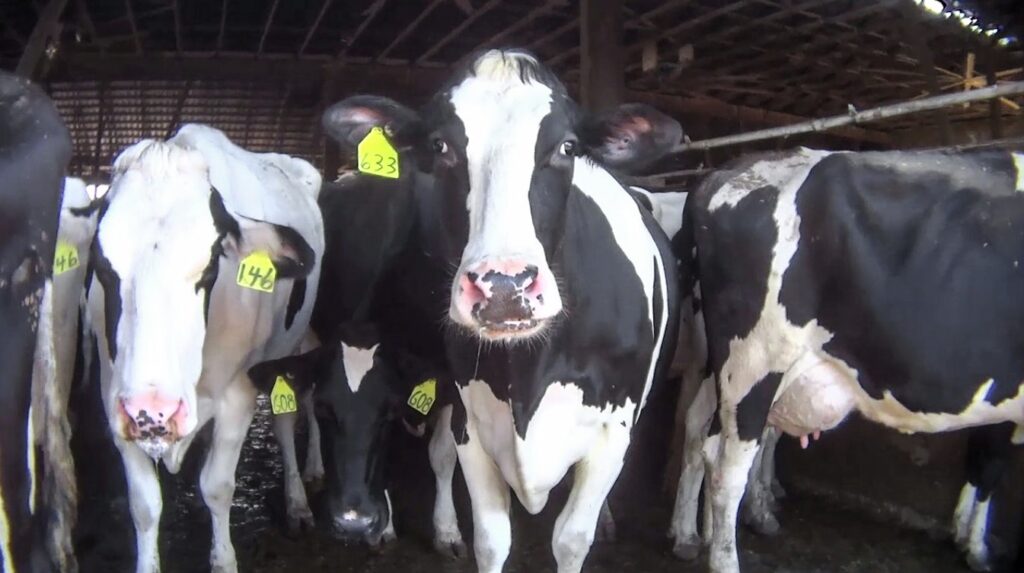
On Dairy Farms, cows are just Milk Machines identified with a number. They sentience is worthless. Dairy cows are made pregnant every year. After nine months, they give birth, and their babies are taken almost immediately. That milk, meant for their child, is taken by humans. After four to six years of this cycle, the cow’s body wears out, and she is slaughtered.
The solution is for people to make the move off milk and onto plant based milk.
Male calves are seen as waste. Some are killed within days. Some are locked in crates and sold for veal. A few are raised for cheap beef. But most will never see adulthood.
To keep this system going, cows are artificially inseminated. One arm is inserted into their anus to position the uterus while semen from a bull is forced into them. The device used is called a rape rack by those who oppose it. It is as disturbing as it sounds.
The bulls are kept alive as long as they produce. Once they cannot, they are slaughtered too.
I am not comparing cows to people. I am comparing the cruelty of ripping families apart. During slavery, human families were torn from each other. In the dairy trade, mothers and babies are ripped apart every single day. It’s the same evil.
Most dairy cows live indoors in crowded barns, standing on concrete, surrounded by noise and filth. Their bodies hurt. Their spirits are broken. There is nothing natural or gentle about the dairy trade. These sweet and affectionate animals are abused milk machines for their entire lives.
Discarded like garbage after a life of slavey – Camels and Donkeys
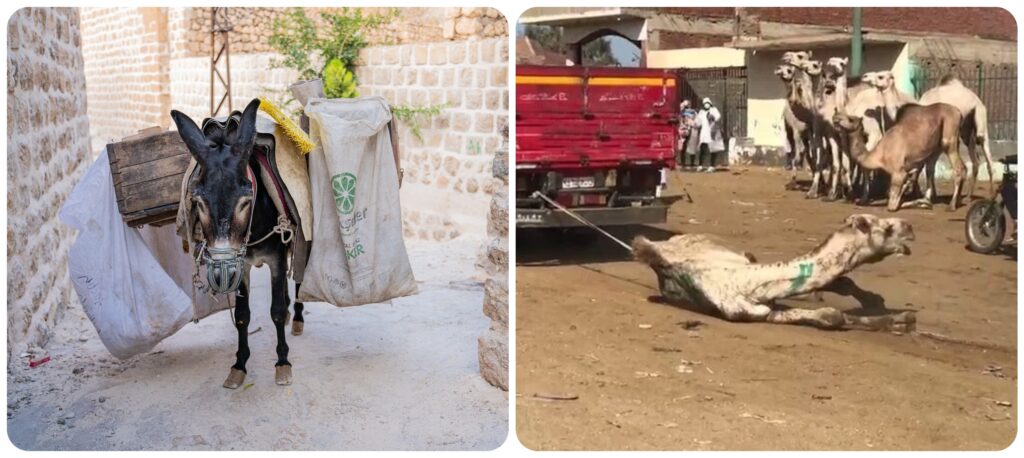
Donkeys and camels are naturally gentle and patient animals, known for their calm temperament and loyalty. The people who abuse and discard them in such cruel ways should be deeply ashamed. These animals deserve respect and kindness, not a life of suffering and neglect.
In Egypt, Ethiopia, India, Pakistan, and Jordan, donkeys and camels endure brutal slavery lasting five to ten years. They are forced to carry heavy loads, pull carts, and travel long distances under harsh conditions with little rest or care. Often beaten, poorly fed, and neglected when sick or injured, their entire existence is one of suffering and hard labor. Camels mostly carry tourists and transport goods across deserts while donkeys handle daily heavy work like carrying water, goods, and farming supplies in crowded streets, dirt roads, and open fields with little shelter or rest.
When these animals can no longer work, many are abandoned, left to scavenge through trash heaps for food, or sold for meat. Some are dumped like waste, left to die slowly from dehydration, starvation, untreated injuries, and exposure to harsh weather. The worst cruelty is the growing trade where donkeys are killed just for their skins, which are exported mainly to China to produce a traditional medicine called ejiao. This cruel business is the main reason donkeys are disappearing fast around the world. Their pain is real, hidden, and often ignored. They deserve better.
As I said early in this article, if some people don’t want to help animals, or they just can’t, at least don’t hurt them.
————————————————————————————————————————————-


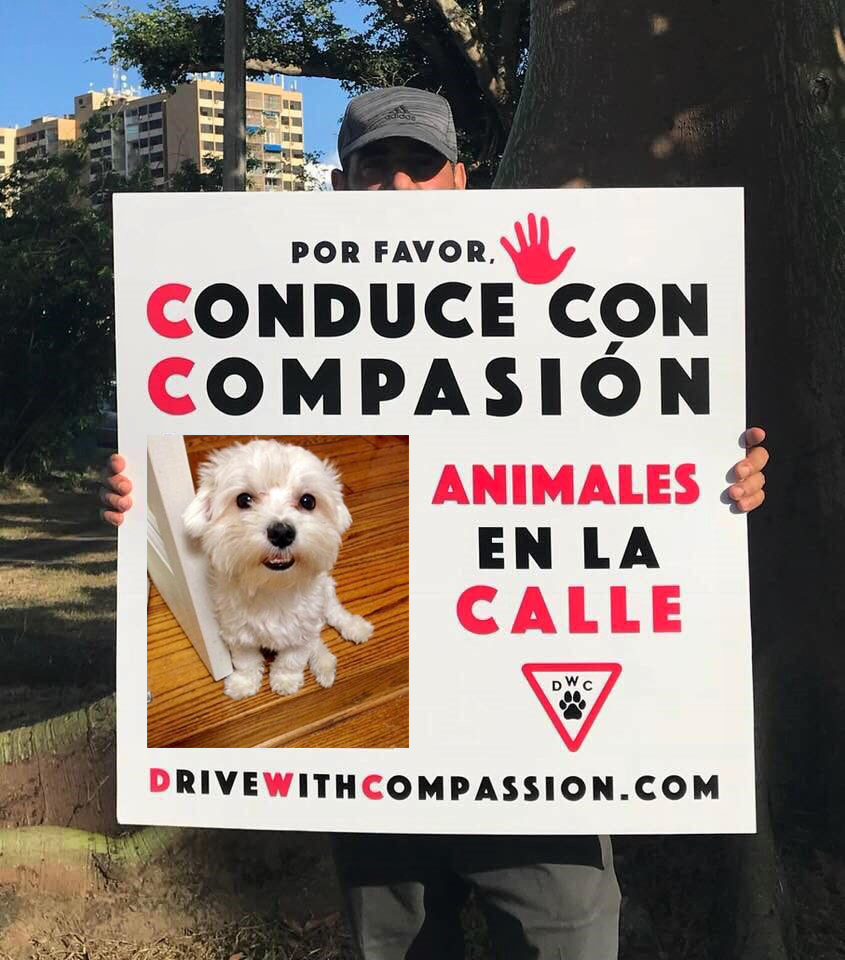
In January of 2018, I created the Drive With Compassion movement for stray animals living in the streets of Puerto Rico and around the world. I had seen too many animals get hit by cars and just discarded like an old Coca-Cola can or something. I could not take it anymore. So, I started pulling animals out of the streets, and at other times, stood in the streets with my Drive With Compassion signs. We cannot always wait for towns or cities to respond, or for laws to change. Sometimes we just have to get out there and be the change we want to see.
When people drove by and saw my signs in the air, they would honk like crazy with excitement. Despite how easy it is to become desensitized, people knew this was a massive problem all over Puerto Rico. So, when they saw someone standing out in the streets addressing that problem, they became inspired. People took a step back and said, “Wait, I can make a difference. I have to stop rushing to meetings that I don’t even have.” And that’s true for many people; rushing to go nowhere.
————————————————————————————————————————————-
The image below is of Dr. Harp Seal with the transcribed message ‘Where is the Geneva Convention for Animals?’ across it.”
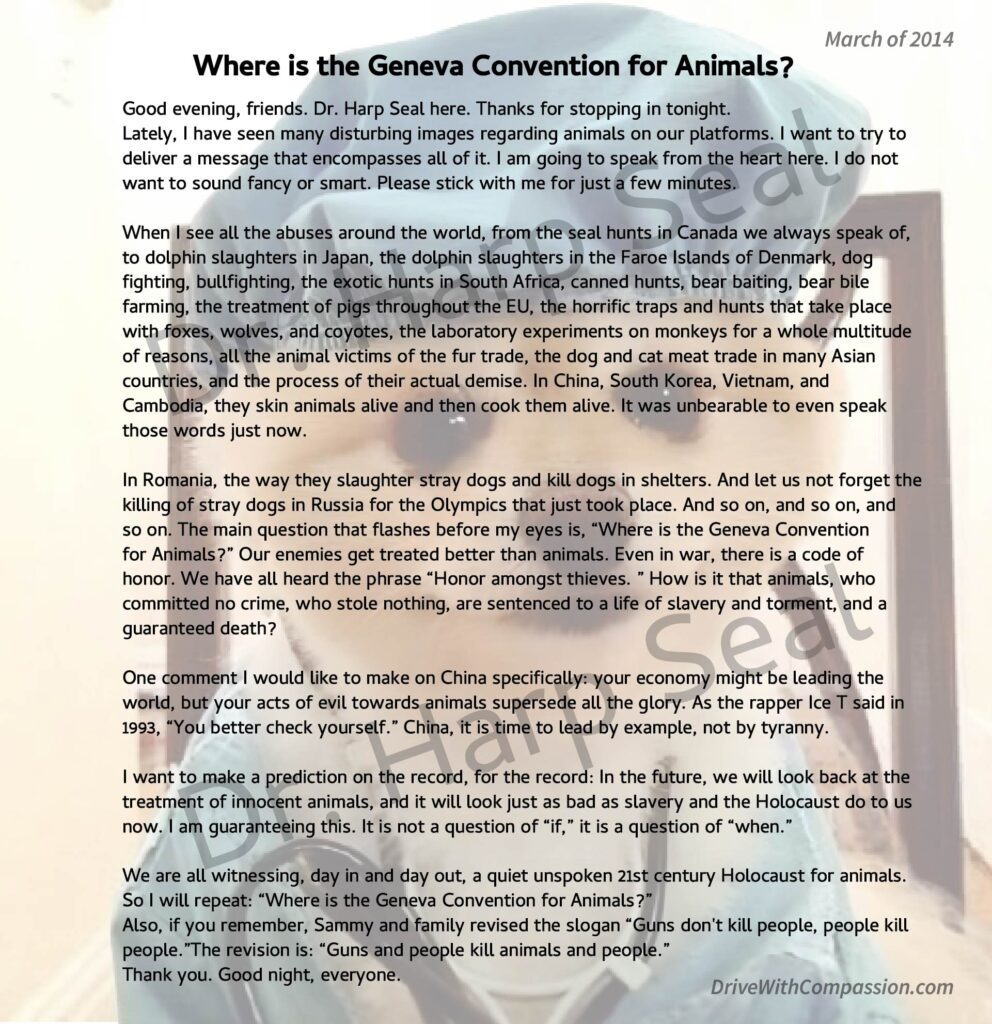
A Doctrine for Animals by Dr. Harp Seal
- The Path to a better world flows through the humane treatment of all animals
- A random act of kindness may not change the world, but it changes the world for the recipient of that kindness.
- Love is the Universal Language. All species speak it.
- If the meek shall inherit the earth. What will the animals inherit. Who’s more meek than them?
- None of our vanities are important enough to make animal suffer.
- Lives before Profits. Not the other way around.
- There can be no true humanity without animals enjoying the freedoms that people do.
- The reason I put animals before people is because people can take care of both animals cannot.
- I never got the email from God or Mother Nature saying people can decide which animals live and which die.
- Nature is brutal on animals. The last thing they needs is for people to stack the deck even further against them.
- Hunting is not a pastime like watching a football game. Hunting is taking a life we don’t have the right to take.
- The fruits of the earth are plentiful enough for all animals and people to live in abundance.
